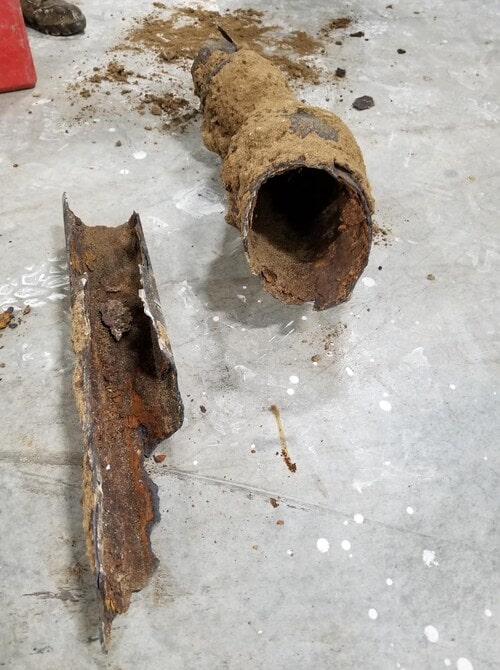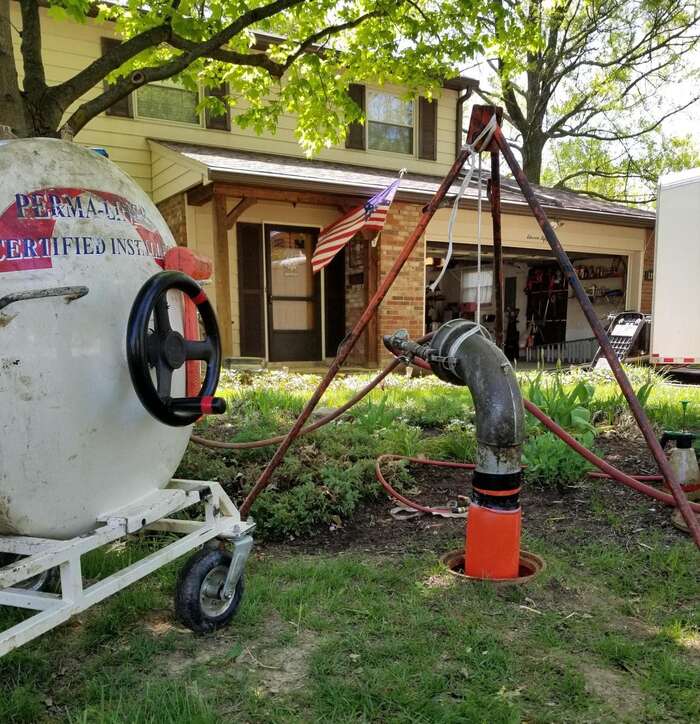Know the Signs of a Collapsed Sewer Line (and What to Do Next)
The average home sewer line has a lifespan of about 60 years, so if you live in an older home, it’s likely your home sewer line has experienced significant deterioration. Known as a sewer lateral, your home’s sewer line is the lifeline that connects your home sewer to the municipal sewer main. If it fails to function properly, all of your plumbing fixtures could back up, causing significant damage to your home. This is especially true if your home has a collapsed sewer line that has crumbled and lost its connection to the municipal main.
Signs of a collapsed sewer line often start as minor inconveniences—a sewage odor lingering in your home, sinks or showers draining slowly—but they can quickly escalate, flooding your yard and even exposing your family to potentially hazardous toxins. Informed homeowners can spot early warning signs and ask local sewer line repair experts to restore their collapsed sewer line with a cost-effective solution before too much damage is done.
What is a collapsed sewer line?
A collapsed sewer line occurs when a home’s sewer lateral crumbles or caves in on itself, often as a result of pipes weakening and corroding with old age or from exposure to harsh environmental conditions. Flow from the home to the municipal sewer main backs up, limiting your home’s plumbing and potentially causing serious damage.
Unlike a clogged toilet or backed up sink, a collapsed sewer line isn’t localized to just one plumbing fixture. All of your plumbing is at risk, so if you have simultaneous slow drains, a collapsed sewer line could be the culprit. A collapsed sewer line can cause serious problems, but the good thing is there are often warning signs before you’re stuck without plumbing altogether. Knowing what causes collapsed sewer lines is a good first step to stay ahead of any potential concerns.

What causes sewer lines to collapse?
A collapsed sewer line is most often the result of damage built up over time. For example, tree roots are attracted to water sources and may be drawn toward your sewer, growing through or around the pipes and weakening their integrity. Corrosion, repeated exposure to harsh environmental conditions and old age are other common causes.
Conditions Known to Cause Collapsed Sewer Lines
Many homeowners inherit a home’s existing sewer pipes when they purchase it, so it’s difficult to know exactly what you’re dealing with. One thing is certain—sewer pipes become less and less dependable as time goes on. Depending on the soil quality, certain pipes might deteriorate more rapidly. The pipe material also determines how well it’ll hold up to corrosion and general wear and tear. Old homes often have Orangeburg pipes, which aren’t as durable as today’s cast iron or PVC pipes. In these cases, worn down pipes are susceptible to collapse, which is why homeowners must pay attention to their home plumbing and keep an eye out for anything unusual.
Incorrect Installation Can Eventually Lead to Collapse
In some cases, your home’s sewer pipes may have been installed incorrectly all those years ago. If pipes are misaligned and don’t match up, leaks will occur, eventually wearing away the surrounding soil. When there’s less soil to support the pipe, there’s nothing to hold it in place, meaning it’s likely to collapse over time. Homeowners can’t always see these problems beneath the surface, but being aware of all the potential pitfalls to your pipes is a good reminder to pay attention and call for help when something is amiss.
Signs of a Collapsed Sewer Line
Homeowners won’t be able to determine whether their sewer line has collapsed for certain without a professional inspection. Still, there are several telltale signs of a collapsed sewer line that can indicate when it’s time to contact a sewer professional, including:
- Slow drains and standing water after using a faucet or shower
- Sewer odors throughout the home
- Gurgling sounds coming from your pipes
- Pipe backupsSinkholes in your yard
- Cracks in your home’s foundation
- Increased presence of pests like rodents and bugs near your home
- Higher water bill expenses
Slow Drains
One of the most obvious signs of a collapsed sewer line is slow draining sinks, showers and bathtubs. Because your home’s sewer lateral connects your home plumbing to the municipal sewer main, all of your plumbing fixtures will experience the consequences when your sewer lateral collapses or fails. If you’re standing in water after a shower or staring at a flooded sink after doing the dishes, a collapsed sewer line may be to blame.
Sewage Odors
A backed-up sewer line means sewage has nowhere to go, often causing odors to permeate the home. Besides being unpleasant, sewage odors can pose a risk to your family if left unchecked because sewer gas or harmful bacteria may be present. If something smells off, it’s worth having your pipes inspected to identify the cause.
Gurgling Pipes
Sewer pipes are at their best when they do their job in the background, not drawing attention. If your pipes are gurgling or making noise, this is your sewer’s way of telling you it’s having difficulty keeping up with the water flow. Gurgling pipes are a strong indicator of a backup somewhere in your sewer line, potentially due to a collapse.
Backed-Up Pipes
If water isn’t passing through your sewer pipes like it’s supposed to, the next best place for it to go is back into your home. A collapsed sewer pipe or blockage in the pipe can halt water flow and flood the nearest outlet in your home, typically a basement, since it’s underground. Backed-up pipes in your basement require immediate attention before your plumbing fails altogether.
Sinkholes
Any water that doesn’t make it back to your basement will likely seep into your yard. A collapsed sewer line can cause leaks that break down the soil surrounding the pipe, creating a sinkhole or a caved in patch of lawn. Collapsed sewer lines wreak havoc on landscaping and are potentially dangerous if the ground is unable to support you or your home.
Cracks in Home Foundation
Similarly to how eroding soil leads to sinkholes, if the damage is bad enough to destroy the ground supporting your home, it adds more strain to your home’s foundation. As a result, cracks start to form and your home’s foundation can deteriorate, as well. This is damage that occurs over time, so it’s essential to contact a sewer professional at the first sign of anything unusual with your plumbing.
Pests Surrounding Home
Backed-up pipes aren’t ideal for homeowners, but for bugs and rodents, a collapsed sewer line can be a beacon drawing them to your home. If you have a recurring pest problem that can’t be explained by another cause, a collapsed sewer line might be serving as a home base for the creepy crawlies in your neighborhood.
Expensive Water Bills
If your home plumbing has slowed down due to a collapsed sewer pipe or another issue, it’s not working as efficiently as you would usually expect. This will be reflected in your water bills, which can be an early sign that your sewer line is deteriorating. Expenses may continue to climb and any damage done to your home as a result of a collapsed sewer line will also add up. It’s best to contact a sewer professional right away so they can determine the most cost-effective sewer line repair solution that is convenient for the homeowner.
Who is responsible for sewer line repair?
Homeowners are responsible for sewer line repair related to the sewer lateral that connects their home plumbing to the municipal sewer main. Problems with the municipal main are the responsibility of the city. If your home is experiencing multiple unexplained plumbing issues, it’s likely your sewer lateral that will require sewer line repair.
Local sewer professionals are well-versed in a number of sewer lateral issues and can help you determine if you have a collapsed sewer pipe or another plumbing concern to address.
What to Do If You Have a Collapsed Sewer Line
The first step is finding a trusted professional sewer repair company to inspect your pipelines. It’s a good idea to ask professionals if they can provide a free sewer inspection to first determine what the underlying issue is before recommending any steps for repair. A collapsed sewer line is a serious concern, but a cracked pipe or even a clog can cause similar symptoms.
If an inspection reveals a blockage, sewer line repair might not even be required. Instead, hydro jetting is a powerful, noninvasive sewer cleaning method that blasts blockages and clears pipes to restore flow. For cracked pipes that are still intact, professionals can install a pipe liner that will coat the sewer lateral and seal the cracks, strengthening the foundation of the pipe from within.

Trenchless sewer repair techniques like pipe lining are often preferred by homeowners because they don’t require digging up your yard to reach the pipe. Pipe liners don’t work for collapsed sewer lines because they need an existing structure to mold to, but there are still cost-saving trenchless sewer line repair options available. It’s important to find a contractor with your best interests in mind and identify solutions that fit within your budget and result in little disturbance to your home.
Collapsed Sewer Line Repair & Replacement Options
For cost-conscious homeowners looking to restore a collapsed sewer line, pipe bursting is the best method to essentially insert a new pipe without digging up your yard. Pipe bursting is a trenchless sewer line repair solution that requires creating two small access points to slide—or “burst”—a new pipe in place of the collapsed pipe, pushing the damaged pipe out. With little mess left behind and no lawn restoration costs necessary, pipe bursting is an efficient, highly effective sewer line repair solution for decades of better-than-ever home plumbing.
An alternative to trenchless pipe bursting is a traditional pipe replacement. However, a pipe replacement tends to be more costly and destructive to your home because the collapsed pipe must be accessed via a gaping trench. Working with trenchless sewer repair experts will ensure you have multiple options available to improve your home plumbing.
CME Sewer Repair specializes in trenchless sewer line repair in Cincinnati, Ohio and beyond, providing prompt sewer inspections and informed recommendations about the most convenient, cost-effective solution to fix your collapsed sewer line. We offer a free sewer camera inspection to get you started!
Suspect a Collapsed Sewer Line? Call CME for Superior Sewer Line Repair Service!
If problematic pipes are causing plumbing trouble at home, CME Sewer Repair is a phone call away. We’ve seen it all in our decades serving Ohio, Indiana and Kentucky residents. Our highly trained technicians have all the tools and expertise they need to identify and repair a collapsed sewer line with our long-lasting trenchless sewer line repair solutions. Contact us to get started with your free sewer inspection.
Schedule Your Free Inspection
To Access Exclusive Updates From CME Sewer Repair, Subscribe To Our Monthly Newsletter Below